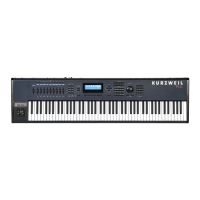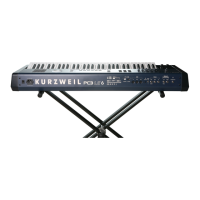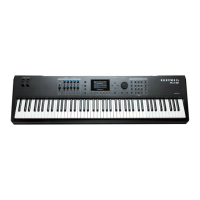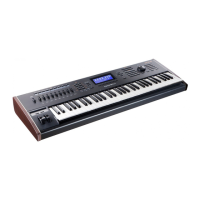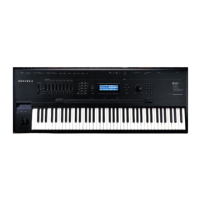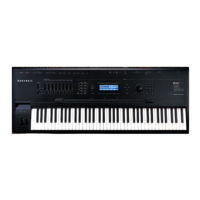Effects
Flanger
9-17
L/R Phase or LFOn LRPhs adjusts the relative phases of the LFOs for the left and right channels
in the stereo Choruses.
Flanger
Flanging is the process of adding or subtracting a signal with a time-displaced replica of itself,
which results in a series of notches in the frequency spectrum, generally referred to as a comb
filter. In the PC3, the flanger is a multi-tap delay line, all (but one) of whose taps can have their
lengths modulated up and down by a low frequency oscillator (LFO). The rate of the LFO is
expressed in Tempo (see Chapter 4).
StatDlyLvl (Static Delay Level) is the level of the first, non-moving tap. Negative values invert
the polarity of the tap. The range is -100 to 100%; 0% turns the tap off.
DlyCrs and DlyFin are the coarse and fine length controls for the Static delay (StatDly…) and
for the minimum value of the moving delays (Dlyn…). The coarse range is 0 to 228 ms, and the
fine range adjusts the coarse range in samples (= 1/48,000 sec = 20.8µsec) from -127 to 127.
Xcurs Crs and Xcurs Fin determine how far the LFO-modulated delay taps can move from the
center of their ranges. The total range of the LFO sweep is twice the excursion. If the excursion is
set to 0, the LFO does not move and the tap behaves like a simple delay line set to the minimum
delay. The coarse range is 0 to 228 ms; the range 0 to 5 ms is most effective for flanging. The fine
range adjusts the coarse range in samples from -127 to 127.
Quantize + Flange
The Quantize portion of this algorithm produces digital distortion known as quantization noise,
by limiting the number of bits available to the signal.
DynamRange (dynamic range) controls how many bits to remove from the signal data words.
The lower the level, the greater the distortion. At 0 dB the hottest of signals will toggle between
only two quantization levels, thereby producing a square wave. Every 6 dB added doubles the
number of quantization levels, reducing the noise and getting closer to the original signal. If the
signal has a lot of headroom (available signal level before digital clipping), then not all
quantization levels will be reached. Range is 0 to 144 dB.
Headroom sets the available signal level before digital clipping. Setting this properly prevents
the signal from getting ridiculously loud at low levels of DynamRange. You want to have it
match the amount of level still available above the input signal: this is done by finding the
DynamRange level at which the signal starts getting louder, and setting Headroom to match the
DynamRange value. Range is 0 to 144 dB.
DC Offset adds a positive DC Offset to the input signal, which allows you to alter the position
where digital zero is with respect to your signal. At low DynamRange settings, this can cause
the output to “sputter”. Range is Off/-79.0 to 0.0 dB.
LaserVerb
LaserVerb is a new kind of reverb which produces a delayed train of closely spaced reflections,
or impulses. As time passes, the spacing between the impulses gets wider, which creates a
discernible buzzy pitch that gets lower as the spacing increases. The signal can be fed back into
itself to extend the effect.
Dly Coarse is the overall delay length, which controls the duration or decay time. 0.5 sec is a
good starting point. Range is 0 to 1.3 seconds in the 2 U version of the algorithm, and 0 to 2
seconds in the 3 U version.

